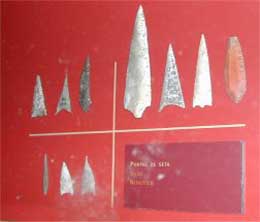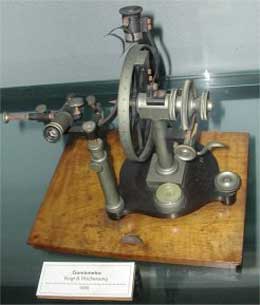The Geological Museum: A Venue that Deserves to be Visited
With its patrimony of great scientific interest, the Museu Geológico presents its visitors with a diversity and wealth of palaeontological, archaeological, stratigraphical and mineralogical specimens that deserve greater attention and dissemination.
Being an integral part of the geological research process initially founded with the Comissão Geológica do Reino in 1848, nowadays the Museu Geológico forms part of the Instituto Geológico e Mineiro. Over the years, this institution, which has dedicated itself to the geological studies of Portugal for more than 150 years, underwent several name changes and organisation models. Right from the first Comissão Geológica created in 1848, under the direction of Charles Bonnet (1816-1867), the path travelled up until the present-day Instituto Geológico e Mineiro went successively through the following bodies: Comissão Geológica do Reino, Comissão Geológica de Portugal, Comissão dos Trabalhos Geológicos, Direcção dos Trabalhos Geológicos, Direcção dos Serviços Geológicos and Serviços Geológicos de Portugal.
The Museu Geológico established itself on the 2nd floor of the building where it is currently located, in R. da Academia das Ciências n.º 19 in Lisbon, between 1855 and 1859 (the 1st floor houses the Academia das Ciências de Lisboa). It brings together the most important group of Portuguese geological collections and one of the oldest and most important prehistoric archaeological collections. In essence, the collections which currently make up the Museum’s patrimony began to be put together at the end of the nineteenth century by the pioneers of Portuguese Geology and Archaeology, Carlos Ribeiro (1813-1882), Nery Delgado (1835-1908), Paul Choffat (1849-1919) and Berkeley Cotter (1845-1919), among others.
The importance of the museum’s existing patrimony is highlighted by the many requests from both national and foreign researchers who wish to carry out research projects in the areas covered by the museum. The materials contained here are references materials for scientific research, which means that any researcher wishing to develop research projects in the areas covered by the Museum has to make use of the information and specimens housed here. Its patrimony is the most important on a national level and an occasional visitor will be unaware of the enormous quantity of specimens kept here in the closets and drawers that fill the various rooms of the museum. Only a fraction of the materials is in fact visible in the closets and showcases on display.
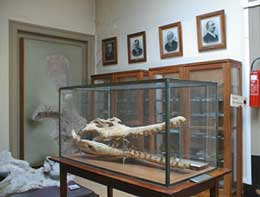 |
|
Palaeontology and Stratigraphy room (general view)
|
The Palaeontology collection includes several thousands of specimens corresponding to the largest part of the fossil specimens known in Portugal and is a crucial reference collection on both a national and international level. This collection contains specimens representing practically all of the palaeontological fossil groups, with particular emphasis on the collections of marine invertebrates, Jurassic dinosaurs and large vertebrates from the Tertiary Period of the lower Vale do Tejo. Of particular importance are the groups of Mesozoic dinosaurs and large tertiary mammals.
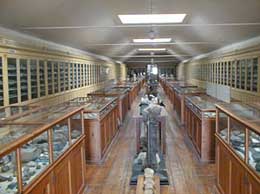 |
|
Palaeontology and Stratigraphy room (general view)
|
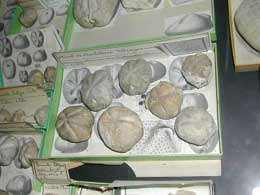 |
|
Fossil specimens
(Palaeontology and Stratigraphy room)
|
The archaeology collection is made up of the patrimony of the various archaeological stations studied by Portuguese researchers and is one of the country’s most important nuclei. The prehistoric archaeological collection covers the period ranging from the Inferior Palaeolithic to the Lusitanian-Roman period, representing more than a thousand archaeological sites throughout the country. The Mesolithic collections of Muge and the Neolithic and Calcolithic collections gathered in the excavations of many caves and funeral monuments, led mostly by Georges Zbyszewski (1909-1999) and Octávio da Veiga Ferreira (1917-1997), as well as the patrimony of the shell middens of Muge (Mesolithic), deserve special mention. Also outstanding, due to their great interest and importance, are the pieces from the Shell Middens of Muge and the Roman minerations of Aljustrel.
The mineralogy collection is predominantly made up of Portuguese minerals, but includes many specimens from the former colonies and from some other countries. The highlight of this collection are the crystals from the Panasqueira mines. There are also dozens of Portuguese and foreign mineral crystals.
The stratigraphy collection includes thousands of fossils and rock samples from dozens of classical geological courts in Portugal and the autonomous regions of the Azores and Madeira.
This museum is of great interest not only to specialists, but also to students and to the entire population interested and curious in having an idea of the extent of the patrimony collected over the years by scholars of several research areas, such as mineralogy, palaeontology, archaeology and stratigraphy.
On display are many palaeontological materials of great interest and which arouse the curiosity of visitors, starting from the vertebrates palaeontology room, where tertiary vertebrate fossils can be seen, most of them mastodontic teeth originally from the sandpits from the surrounding areas of Lisbon. This room and the Palaeontology and Stratigraphy room contain one of the largest and best European collections of tertiary vertebrates. The display cabinets contain Portuguese fossil vegetable specimens, arranged in stratigraphic order. The central part contains some large pieces of fossil reptiles.
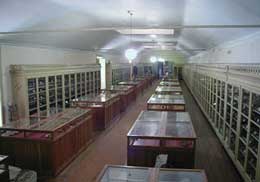 |
|
|
|
The Prehistoric Archaeology room contains part of the archaeological patrimony of various prehistoric periods, ranging from the Palaeolithic to the Lusitanian-Roman period. In the central display cabinets the many duly identified artefacts are well worth a closer look.
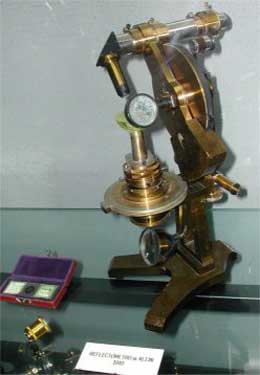 |
|
Klein’s Reflectometer, 1910
|
The Mineralogy room contains only a few specimens of Portuguese and foreign minerals, with particular emphasis on the large crystals from the Panasqueira mine. The mineralogical collection itself is reserved for researchers. Also on display in this room are some instruments used by researchers at the end of the nineteenth century and beginning of the twentieth century, such as microscopes, reflectometers and goniometers.
The museum itself is a historical testimony of the end of nineteenth century and beginning of the twentieth century as many of its display cabinets are several decades old. For more information, please visit the Museum’s webpage.
Fernando Reis





